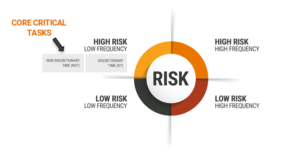Editor’s note: This article is part of a series. Click here for the previous article.
Gordon Graham here and hello again. In our last time together in this series on “real” risk management, we chatted about the value of ongoing training—and not random training, but training focused on your specific “core critical tasks.” Here is the graphic to help you better identify your specific core critical tasks.
Throughout history people in every high-risk profession have demonstrated the value of constant and rigorous training. Many of you are reading this at work (it is job-related, after all). Let’s say you are sitting at your desk and out of the blue you hear a scream—a serious scream—someone is in big trouble. You hear shots being fired and more screaming and you instantly recognize that a “workplace violence event” is happening. For you, this is a core critical task—very risky, done very rarely and with no time to think.
Or perhaps you leave your desk to go down the hallway to get a free cup of coffee and you see a coworker collapse to the floor with some medical condition. Again for you, this is a core critical task—very risky, done very rarely and with no time to think. You must act now to save the life of your coworker.
Some acts of nature create core critical tasks. Annually I read about hurricanes in Florida and the Carolinas. These events are not core critical tasks because they don’t sneak up on us. Hurricanes are tracked for days in advance—the weather prognosticators even give them names. We watch them in advance through satellite imagery and today we can predict with good accuracy when and where these weather events will hit, often down to specific communities.
But let’s travel 2,460 miles west on the Christopher Columbus Transcontinental Highway (aka I-10) as you cross Interstates 95, 75, 65, 55, 45, 35, 25, 15 and 5 (My gosh, it almost looks like there was some planning involved in the building of the Eisenhower Interstate Highway System!) to the terminus of I-10 in Santa Monica. Pretend you are a cop in Santa Monica.
You must identify the core critical tasks you may face, prioritize them in terms of potential frequency, and then mobilize—ACT—in advance to prepare your response to these events.
As you sit at your desk at the Santa Monica Police Department enjoying your Maximus Grande Frappuccino Mocha Whip Ringers Lactate D5W Turbo-Infused Javanese Latte with a sprinkle of cinnamon that costs $5 (that would be 25 dollars a week, 100 dollars a month, 1,200 dollars a year, 12,000 dollars in 10 years and 36K over a 30-year career, not including any rate of inflation—but I am digressing), without warning the building starts to shake violently and you recognize you are involved in some serious seismic event—an earthquake.
While the hurricanes in Florida announce their presence days in advance, the earthquake does not give us a similar warning. You must act immediately. This is a core critical task—again, very risky, done very rarely and with no time to think. You must act now to avoid falling furniture, provide instant medical attention to coworkers who are hurt, secure confidential files, assist the employee who uses a wheelchair and successfully evacuate the building.
Speaking of the Florida-California reference, a couple years ago I was in Lakeland, Fla., at 0400 and getting ready for my work day with the Polk County Sheriff’s Office. That morning the news was dominated by reports of a multiple-fatality shooting in Thousand Oaks, Calif.
There you are—the cop on the traffic stop at 2300 hours with your head on a swivel, keeping your eye on all the risks involved in this stop—passing traffic, pedestrians, the people in the vehicle you have stopped—and you hear rapid-fire gunshots coming from the nearby country western bar. Every active-shooter event is a core critical task.
By now you are probably bored with this writing, but there is a method to my madness. Please go all the way back to the early pieces in this ongoing series and remember the definition of “risk management” and your role in Recognition, Prioritization and Mobilization. You must identify the core critical tasks you may face, prioritize them in terms of potential frequency, and then mobilize—ACT—in advance to prepare your response to these events.
As we wrap up this piece please do not think, “There is nothing I can do; bad things are just going to happen.” Please look at the actions of Cyril Richard Rescorla and what he did on September 11, 2001 (and for those of you who are really into this, his work long before that terrorist event). Or perhaps you can read about the USS San Francisco and the actions of its crew on January 8, 2005.
For those of you interested in aviation events, consider the actions of Captain Sullenberger on US Air 1549 on Jan. 15, 2009. Do not think, “He got lucky.” Read his history prior to the “Miracle on the Hudson.”
But here is one you probably are not familiar with: American Airlines Captain Bryce McCormick, truly a great American who identified a potential core critical task—and trained extensively to prepare for it.
Well that’s it for this writing—I am off to work. Thanks again for reading. Until next time!





